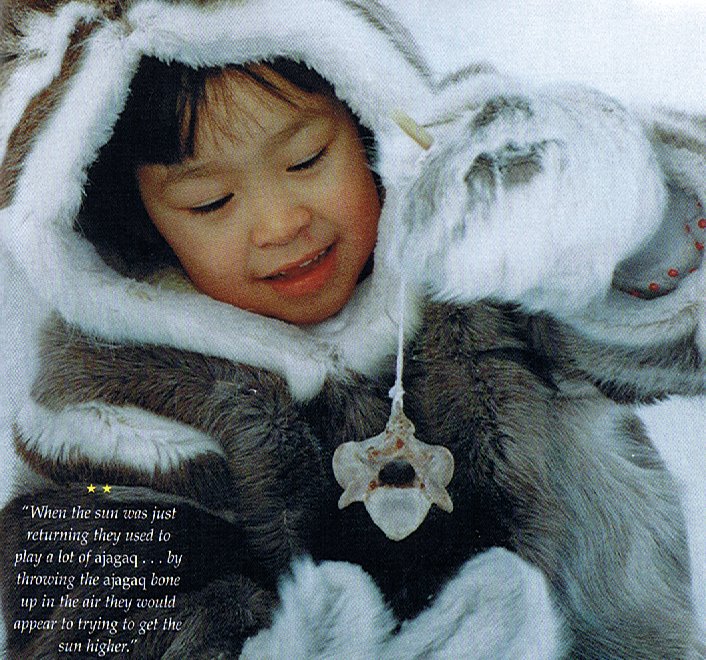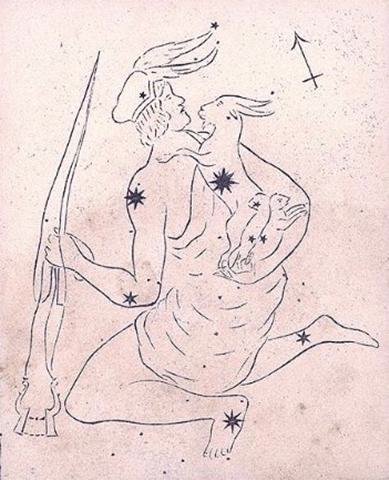If Metoro's tagata tua ivi referred to a pair of stars connected with string games and given that his tua alluded to the lunar night Otua, then the question remains as to what ivi might mean. Possibly ivi was referring to some other game. We remember ajagaq, playing with a Sun bone (ivi). Among the Inuit peoples Sun was a female and Moon a male:
... The text says: 'When the sun was just returning they used to play a lot of ajagaq ... by throwing the ajagaq bone up in the air they would appear to be trying to get the sun higher.' In spring it is important to 'get him up' - it is the season of procreation ... At the beginning of June the Easter Island midwinter was not far ahead. It was not a season for games helping Sun climb higher. Possibly tagata tua ivi could refer to a completed (tagata) 'year in leaf', when Sun was moving closer and closer to Mother Earth (te henua).
The last glyph in line Cb2 has 17h at the other end of the year and the first glyph in line Cb3 has RA night 260 at the other end of the year. The other end of the year - compared to June in the Gregorian calendar which had midsummer ahead - should mean midwinter was ahead. The pair of stars involved should be in Auriga, a man (tagata) who has goats at his back (tua):
Anciently Haedus I (ζ) was a bad sign for the sailors, because it marked the end of their season of sailing: "... Vergil ... made special allusion to the dies Haedorum, and with Horace and Manilius called them pluviales, the latter author's Stormy Haedi ... which shut the Main // And stop the Sailors hot pursuit of gain. Horace similarly knew them as horrida et insana sidera and insana Caprae sidera; and Ovid as nimbosi, rainy. They thus shared the bad reputation in which Capella was held by mariners, and were so much dreaded, as presaging the stormy season on the Mediterranean, that their rising early in October evenings was the signal for the closing of navigation." (Allen) When Haedus I was rising with the Sun it could not be seen and there was no threat of storms. From classical times to the time of rongorongo the precession would have pushed the star ahead in the year with about a month and their bad influence in the night sky would reasonably have moved from October to November. On Easter Island the month October is comparable to April in being a spring month and there should be no hairy (winter) goats connected with the Auriga man but instead its opposite - viz. dry old bones without any covering at all. Tagata atua ivi could mean Auriga in the night sky was a good sign of summer ahead. The lunar night O-tua (Ca7-16) could have been placed at September 21 (264) by the creator of the C text in order to have this date close to 12h as a Sign of summer ahead. September 21 is comparable to March 21. When the 'Goat Door' (Haedus I and II) rose heliacally in early June its stars could not be seen, but of course it was known where they were, viz. close to the Sun. Metoro may have meant the bad influence for sailing was not there - in early June tagata tua carried no hairy goats. His statement could refer to conditions north of the equator, not to those on Easter Island. However, by repeating tagata tua ivi twice he negated his own statement, turning it to a possible reflection on how on Easter Island in early June the Auriga stars meant 'no bald bones ahead' (= 'goats ahaed'). It is quite confusing, because we have also to consider the fact that the goats are at the back side of the Charioteer. This ought to mean they are in the past. But if Haedus I and II (and Capella) are at the back side, then they can hardly indicate a solstice ahead. Either they should indicate winter solstice in the past (if rising heliacally) or some date between winter solstice and spring equinox. Cb2-25 has no overturned 'canoes' (crescents) in front, they are right side up and ready to sail. High summer was ahead.
Instead of strings the Charioteer has goat leather thongs ahead and from February to June there are 4 months: ... Februa, also Februatio, was the Roman festival of ritual purification, later incorporated into Lupercalia. The festival, which is basically one of Spring washing or cleaning (associated also with the raininess of this time of year), is old and possibly of Sabine origin. According to Ovid, Februare as a Latin word which refers to means of purification (particularly with washing or water) derives from an earlier Etruscan word referring to purging. The Roman month Februarius ('of Februa', whence the English February) is named for the Februa/Februatio festival, which occurred on the 13th to 15th days of this Roman month. A later Roman god Februus personified both the month and also purification, and is named for them. Thus, the month is named for the festival and not for the god ... When north of the equator Sun has crossed the Milky Way River to Auriga on its northwestern bank, then south of the equator the Eridanus River is ending at Rigel.
Possibly the 4 glyphs from Pleione 1 are illustrating the beginning of the sailing (or fishing) season. The Auriga stars (Hassaleh, Almaaz, and Haedus I) are coordinated with the end (tagata) of a season, seemingly illustrated as a pair of double glyphs. Clearly 'fishing' is the subject matter. And Ga1-8 is not the same as Ga1-10, thus no negation. But maube this had to be 'translated' to December 1-4 on Easter Island, to the nights when Rigel was seen close to the Moon in the night. In the parallel K text, however, there evidently was no necessity to 'translate' from north of the equator to south of the equator:
Here seems to be illustrated the end of the fishing season, with ihe tau (end of season) instead of henua and no heads visible. In June and on Easter Island bad winter weather was ahead. Strings are necessary when fishing with lines out on the sea. At June 1 Metoro said ku kikiu, which possibly means south of the equator the string season 'was satiated' (ku) - finished:
To fish with strings out on the 'Sea' would be a bad Sign for the Sun who was attempting to rise (move up onto 'Land'). Especially if he sometimes was compared to a rising fish. | ||||||||||||||||||||||||||||||||||||||||||||||||||||||||||||||||||||||||||||||||||||||||||||||||||||||||||||||||















